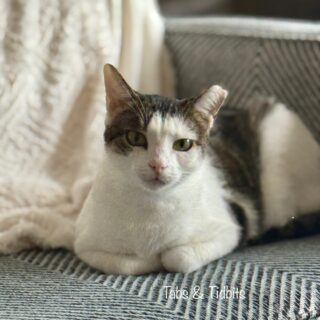
This post is about Cooper’s diagnosis of hyperthyroidism (overactive thyroid). Hyperthyroidism is a common disease among cats. There are a lot of theories on why cats develop hyperthyroidism, but as of present-day there is no known primary culprit. Since hyperthyroidism is such a common disease and it is manageable and even curable, I wanted to share my experience with Cooper. If you are facing hyperthyroidism with your cat(s), I hope Cooper’s story will shed some light. If your cat(s) thyroid is in good health, I hope it will remain in good health; but if you were to face hyperthyroidism down the road, perhaps Cooper’s story will help. Hyperthyroidism in cats is a serious disease that must be treated quickly. If left untreated, the hyperthyroidism will progress causing other health conditions, organ damage and will most likely lead to death.
When I started Tabs and Tidbits, I wanted to make it a point to share with you the medical events Cooper has been through. Before I take you through Cooper’s health background, I want to emphasize that I am not a veterinary healthcare professional. Your pet’s health should always be directed to your pet’s veterinarian. The health and care of Cooper and the choices made are always thoroughly discussed with Cooper’s doctor.
What is hyperthyroidism?
According to Cornell University College of Veterinary Medicine, Hyperthyroidism is a very common disease afflicting primarily middle-aged and older cats. Also called thyrotoxicosis, hyperthyroidism is caused by an increase in production of thyroid hormones (known as T3 and T4) from enlarged thyroid glands in the cat’s neck. In most cases, enlargement of thyroid glands is caused by a tumor called an adenoma, which is non-cancerous. Some rare cases of hyperthyroid disease are caused by malignant tumors known as thyroid adenocarcinomas.
What cat breeds and ages are prone to hyperthyroidism?
According to pets.webmd.com, Hyperthyroidism can occur in any breed of cat, male or female, but occurs almost exclusively in older animals. Less than 6 percent of cases are younger than 10 years of age; the average age at onset is between 12 and 13 years.
(Cooper’s hyperthyroidism started at age 11. He is a male domestic shorthair cat.)
What are the signs of hyperthyroidism?
According to Cornell University College of Veterinary Medicine, Cats afflicted with hyperthyroidism usually develop a variety of signs, which may be subtle at first but then become more severe as the disease progresses. The most common clinical signs of hyperthyroidism are weight loss, increased appetite, and increased thirst and urination. Hyperthyroidism may also cause vomiting, diarrhea, and hyperactivity. The coat may appear matted or greasy.
What is causing cats to develop hyperthyroidism?
There is no answer to that question. There are a lot of theories, but the research has not given us a definitive answer to that question. Without knowing that answer, I do not know how to recommend prevention. However, the disease can be managed. There is even a cure to hyperthyroidism, and your cat(s) can recover from the disease.
Cooper’s Story:
Around the age of 11 Cooper started showing signs of having an overactive thyroid. (I will give more specifics on the symptoms below.) The signs of the illness were subtle, so we just kept a closer eye on Cooper. Over the course of just a few months, the symptoms became more severe, and it was clear that something was not right with Cooper. We took Cooper to see his doctor for an exam. Since there can be a variety of health conditions to look for, Cooper’s doctor conducted a physical exam along with ordering a battery of tests. Once the lab results came back, Cooper was officially diagnosed with hyperthyroidism.
Based on the signs of hyperthyroidism, Cooper experienced all of them in except his coat always appeared healthy. Below are some of the most common symptoms Cooper developed.
Increased Appetite & Weight Loss: Cooper’s appetite slowly started to increase. Not that we thought that was strange at first. Cooper has always enjoyed his meals, so we were happy to see Cooper enjoying his food. Especially since he was on a prescription food diet from a previous diagnosis. The problem was Cooper was losing weight. Although Cooper could afford to lose a few pounds, an overactive thyroid is not how any cat should lose weight. Please note, we did not notice Cooper’s weight loss. His weight loss was caught at his appointment with his veterinarian. Fortunately, that meant Cooper’s hyperthyroidism was caught early enough where it had not taken a dramatic toll on his body.
Note: If your cat is eating and/or drinking more than usual take him or her to the vet as soon as possible.
Excessive & Uncontrollable Vocalization: Cooper started meowing more often. I love hearing Cooper meow. It is great to hear him talk, but something was off about his meow. He would just walk around the house meowing at sporadic times. He was not meowing for or at anything. I know Cooper’s habits, and Cooper is not a chatty cat. He meows for a reason, and this was out of the norm for Cooper. However, the most obvious and disturbing vocalization that stood out was when Cooper looked extremely confused, panting, meowing excessively and uncontrollably. In about a minute, he would stop and go about his usual business. Cooper’s doctor informed me that Cooper was having Thyroid Storms. Thyroid Storms are serious and should be addressed immediately with your vet. Below is a video to give you a visual and audible example of what a Thyroid Storm is like for a cat.
So, Cooper joined the large group of cats that developed hyperthyroidism.
Next week, I will share with you the treatment options available and the choice we made for Cooper. As serious and as scary as the diagnosis of hyperthyroidism can be, if treated early, your cat(s) can live a healthy life and even fully recover. If you don’t catch it early, there are still treatments available and you and your veterinarian can work on a management plan for your cat(s).
In closing today, I wanted to emphasize how important regular vet visits are for your pet. In addition to the physical exam, the extensive lab tests (CBC, chemistry panel, etc.) are crucial. (In layman terms, I call it the blood work). Most vets will ask if you want them to order blood work since the price can be costly. Please, always agree and if not asked, request the blood work at each physical exam (usually an annual visit). If your pet is a senior, you will need to have the senior blood work ordered. I cannot emphasize enough how these tests can be a quality of life or even a life-saving decision for your pet. Many ailments cannot be seen right away in the physical exam alone. The blood work can reveal health conditions earlier than if you started to see the physical signs. The blood work is costly but it is affordable. Preventive care is key to giving your pet the most healthcare options.
If you think your cat(s) is showing signs of hyperthyroidism, please make an appointment with you veterinarian immediately.
Special Thanks to Riverview Animal Clinic.




